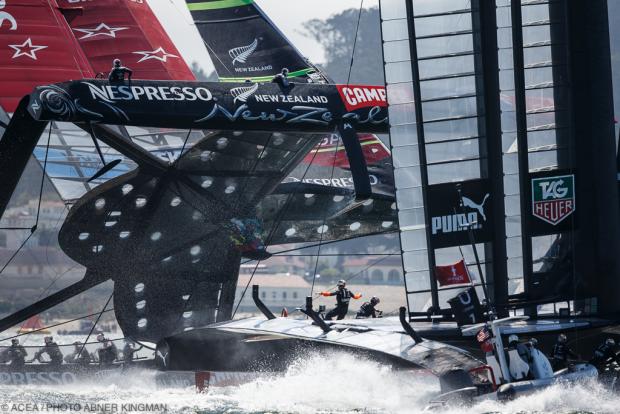
Tell us about this photo.
It was a close race, and on the windward leg ETNZ had a slight lead. As the two boats approached each other with Emirates on port and Oracle on starboard, Emirates tried to tack on top of Oracle, but their wing articulation hydraulics failed and they couldn’t trim properly. They started to capsize and it seemed to unfold in slow motion. I had a 500mm lens on my camera, which seemed too long as the starboard hull kept lifting and it seemed as if the edges of the frame were getting crowded. I thought I might lose the shot altogether, but knew there was no time to switch cameras, so I just kept shooting. The boat hung at the point where this frame was taken and then started coming back down. Often when something unexpected happens, you don’t have the ideal lens and you end up losing the shot or cropping heavily in an attempt to salvage something. This is the full frame, exactly as I shot it – no skill in that, just luck.
What was it like to be on the water when Emirates Team New Zealand almost capsized?
I was on the aft deck of the TV catamaran and we were following the boats up the course. The TV cat accelerates and decelerates quickly, turns sharply, and sends walls of spray over the deck without warning, so you are never 100% focused on taking pictures, always trying to anticipate the boat’s motion. But when ETNZ started tipping up it was so captivating that I can’t even say whether we were still moving or not. After the starboard hull splashed back into the water I realized that everybody else aboard the boat had been shouting, and I hadn’t heard it before.
What has it been like covering the America’s Cup this year?
There is always something to shoot. The racing is just a small part of the work, and shooting it is often the most relaxing part of the day. There are lots of other activities to shoot and photo requests to fulfill each day, often finishing late with a concert or evening party. Then, of course, there is the editing, always on tight deadline, without time to mull over your decisions. It’s very exciting, even the one-boat races we had early on in the Louis Vuitton Cup were exciting from a photographer’s perspective, but after several months, there is definitely some cumulative fatigue from operating long hours at high intensity day after day – and we are still going!
What are the challenges of taking photos at a high speed, high stakes race like the America’s Cup?
The boats are spectacular. I’m not sure how well that comes through on TV or in the photos, but they are not like anything you have ever seen on the water before. And when you are near them you can appreciate how fast they are really moving, how unstable the are, and how much skill and effort is required to keep them upright. Near is a relative term, though. The umpire boats are quite close, the team chase boats are a bit farther away, and everyone else is farther still. From a photographic perspective we are never close enough. It is very hard to show the faces of the sailors when they are actually racing. Some days I shoot with an 800mm lens in an attempt to capture some emotion, but with the helmets, distance and speed, it is mostly an exercise in frustration.
What camera do you use?
I shoot with Canon cameras. Currently, I am using a 1Dx and a 5D MK III. The 1Dx is faster and has better weather sealing, but it’s a lot more expensive.
What are your favorite shooting conditions?
The rougher the better. The camera has a way of flattening seas, so if you want to show some waves it has to be fairly rough. I’d rather be closer to the action and shooting a wide angle lens than farther away and shooting a telephoto. It’s really about the people first, and the machines they are operating second. I think that people exercising skill and/or determination to manage challenging conditions or difficult equipment makes the best photos.
How did you get started in photography? What did you do for work before you became a photographer?
I started out thinking I would be a marine biologist from the time I was about seven years old. After college I was working working with a scientist at Woods Hole Oceanographic, and, a couple of years into the project, he died from cancer. I had been just about to begin my PhD work at URI, but took a detour and went to work on boats for a while. After some time offshore I returned and decided to go to journalism school. After school I started picking up work in areas I was familiar with – commercial fishing and sailing.
Any advice for aspiring sailing photographers?
Shoot a lot – really a lot – and be fearless about experimenting with your creativity. Then edit your own work with a critical eye. What works and what doesn’t? What message or emotion are you trying to convey to people who will view the image? Spend time looking at established photographers’ work, but try to avoid becoming imitative or derivative. They may have succeeded with their style, but that doesn’t mean it’s the only way to go.
Click here for previous installments of the Photo of the Month.









